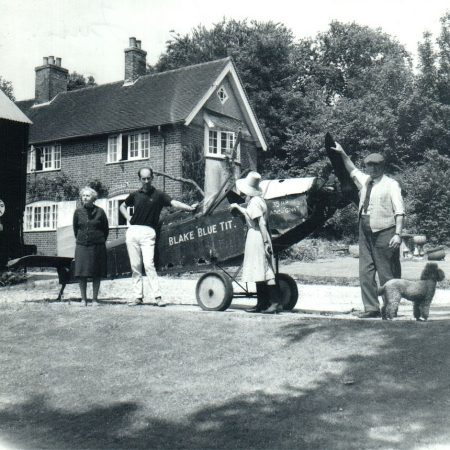In Herefordshire, close to the Welsh border, an aeroplane is being restored that was first built and flown above the Hampshire countryside 90 years ago. This is the Blake Blue Tit, built by William Henry Cundell Blake(1906-1988), known to all his friends as Billy.
Billy was brought up at Woodhams Farm, Kings Worthy, close to the Royal Flying Corps (RFC) airfield at Worthy Down. At a young age he watched air balloons float graciously over the fields and was thrilled with the antics of Australian pioneer Sydney Pickles, when he came to Winchester in 1913. Despite numerous engine problems, and a navigation error that took him to Compton instead of Harestock, Pickles eventually got safely airborne in a Handley Page 4 machine.
Billy’s father, Frank Cundell Blake (1872-1961) was a very successful local auctioneer and land agent and was convinced that his son should follow in his footsteps. He was taken on by James Harris, the Winchester estate agents, but after two years decided it was not for him. Instead he went off to Cornwall to train at the Camborne School of Mines. This took him to Sierra Leone, Nigeria and the Gold Coast, where he worked as a mining engineer.
His passion for flying was, however, unabated and in 1929 he obtained a private pilot’s licence at the Hampshire Aeroplane Club, Hamble, flying solo in an Avro Avian aircraft. It was shortly after this that he decided to build his own machine.
After a fashion, he designed it himself – but in reality it was essentially the parts of two professionally built planes joined together, with other items salvaged from here and there. For the fuselage he used a Simmonds Spartan machine, built by Simmonds Aircraft Ltd, which had been founded at Woolston in 1928 by Oliver Simmonds (later renamed Spartan Aircraft following financial difficulties). Billy made use of the wreckage of a plane that had crashed at Leicester. The wings – suitably adapted – came from an Avro 504K.
The engine was rated at 35HP and came from a kind of flying bomb pioneered by the RFC – rather like a drone – but it failed because its electronics were not up to the job. Billy, however, made use of the engine. The petrol tank was from a Morgan 3-wheeler, with a tiny capacity of one and a half gallons, and the wheels from a De Havilland Moth.
At one stage the propeller was damaged, but was soon re
-profile
d with a spokeshave. What is astonishing is that anyone would risk their life in such a contraption, especially only a year after qualifying as a pilot. But Billy, helped by his brother, Richard, pressed ahead and took to the air successfully and flew a
round Kings Worthy, albeit only for a short while.
For Billy the escapade, although totally illegal, was a crowning achievement. But much more was to come. He was busy building the Winchester Bypass and much more in the years before the war.. And when it came he joine

d the Fleet Air Arm, eventually becoming a Lt Cdr RNVR in a training capacity, initially at Worthy Down, where one of the trainee pilots was a certain Laurence Olivier, and later at Anthorn, Cumberland. He eventually logged 2,300 hours in 56 different types of aircraft.
There is much more to tell of Billy Blake, whose interests and achievements were legion. His story has been researched by Tony Dowland, a founder member of the Worthys Local History Group. For more, see: HRO, 153M89, and 141M90/47; and Finn, P. and Johnson P., eds., A History of the Worthy Villages, 1999, Headbourne Worthy.
For more, see: HRO, 153M89, and 141M90/47; and Finn, P. and Johnson P., eds., A History of the Worthy Villages, 1999, Headbourne Worthy.

